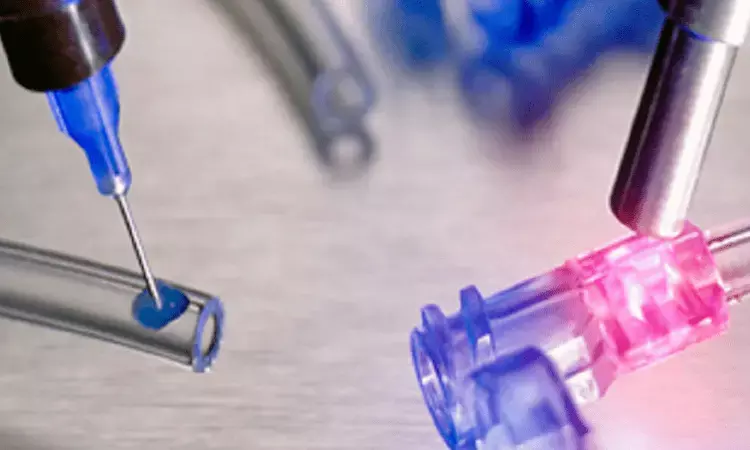- Home
- Medical news & Guidelines
- Anesthesiology
- Cardiology and CTVS
- Critical Care
- Dentistry
- Dermatology
- Diabetes and Endocrinology
- ENT
- Gastroenterology
- Medicine
- Nephrology
- Neurology
- Obstretics-Gynaecology
- Oncology
- Ophthalmology
- Orthopaedics
- Pediatrics-Neonatology
- Psychiatry
- Pulmonology
- Radiology
- Surgery
- Urology
- Laboratory Medicine
- Diet
- Nursing
- Paramedical
- Physiotherapy
- Health news
- Fact Check
- Bone Health Fact Check
- Brain Health Fact Check
- Cancer Related Fact Check
- Child Care Fact Check
- Dental and oral health fact check
- Diabetes and metabolic health fact check
- Diet and Nutrition Fact Check
- Eye and ENT Care Fact Check
- Fitness fact check
- Gut health fact check
- Heart health fact check
- Kidney health fact check
- Medical education fact check
- Men's health fact check
- Respiratory fact check
- Skin and hair care fact check
- Vaccine and Immunization fact check
- Women's health fact check
- AYUSH
- State News
- Andaman and Nicobar Islands
- Andhra Pradesh
- Arunachal Pradesh
- Assam
- Bihar
- Chandigarh
- Chattisgarh
- Dadra and Nagar Haveli
- Daman and Diu
- Delhi
- Goa
- Gujarat
- Haryana
- Himachal Pradesh
- Jammu & Kashmir
- Jharkhand
- Karnataka
- Kerala
- Ladakh
- Lakshadweep
- Madhya Pradesh
- Maharashtra
- Manipur
- Meghalaya
- Mizoram
- Nagaland
- Odisha
- Puducherry
- Punjab
- Rajasthan
- Sikkim
- Tamil Nadu
- Telangana
- Tripura
- Uttar Pradesh
- Uttrakhand
- West Bengal
- Medical Education
- Industry
Light-curing adhesives have less cytotoxic and hormonal effects compared to chemically polymerized adhesives

Light-curing adhesives have less cytotoxicity and hormonal effects compared to chemically polymerized adhesives suggests a new study published in the Journal Angel orthodontist.
Researchers have found in a new study that among patients in whom indirect bonding adhesives were used, Light-curing adhesives released a significantly less amount of monomer than chemically cured adhesives. Therefore Light-curing adhesives are safer than chemically polymerized adhesives and have less potential for cytotoxicity and hormonal effects.
A study was done to quantify the amount of residual monomer released from orthodontic adhesives used in the indirect bonding technique and compare it to a direct bonding composite resin.
Five hundred stainless steel orthodontic brackets were bonded on bovine incisors using five groups of bonding resins: Transbond XT (TXT), Transbond Supreme LV (SLV), Sondhi Rapid-Set (SRS), Transbond IDB (IDB), and Custom I.Q. (CIQ). Liquid samples were gathered on the first, seventh, 21st, and 35th days. Residual monomer release was measured from the liquid samples with a liquid chromatography device. In addition, the amount and shape of the adhesive between the tooth surface and the bracket base was evaluated using obtained electron microscopy images. The data were analyzed using analysis of variance, and a Tukey post-hoc test was applied.
Results
Hydroxyethyl methacrylate and bisphenol A-glycidyl methacrylate monomers were released by all study groups. Urethane-dimethacrylate was released from the TXT, SLV, IDB, and CIQ groups. Triethylene glycol dimethacrylate was released from TXT, SLV, IDB, and SRS groups. The amount of total monomer release was higher in chemically cured adhesives than in light-cured adhesives. Among the chemically cured adhesives, premix adhesives had the highest amount of total monomer release. The light-cured adhesives had less thickness.
Light-curing adhesives have significantly less monomer release than chemically polymerized adhesives.
Reference:
Comparison of residual monomer amounts released from indirect bonding adhesives
Yasin Hezenci; Berat Serdar Akdeniz. Angle Orthod (2023). https://doi.org/10.2319/122322-864.1
Keywords:
Light-curing, adhesives, less, cytotoxicity, hormonal, effects, compared, chemically, polymerized, adhesives
Dr. Shravani Dali has completed her BDS from Pravara institute of medical sciences, loni. Following which she extensively worked in the healthcare sector for 2+ years. She has been actively involved in writing blogs in field of health and wellness. Currently she is pursuing her Masters of public health-health administration from Tata institute of social sciences. She can be contacted at editorial@medicaldialogues.in.
Dr Kamal Kant Kohli-MBBS, DTCD- a chest specialist with more than 30 years of practice and a flair for writing clinical articles, Dr Kamal Kant Kohli joined Medical Dialogues as a Chief Editor of Medical News. Besides writing articles, as an editor, he proofreads and verifies all the medical content published on Medical Dialogues including those coming from journals, studies,medical conferences,guidelines etc. Email: drkohli@medicaldialogues.in. Contact no. 011-43720751


